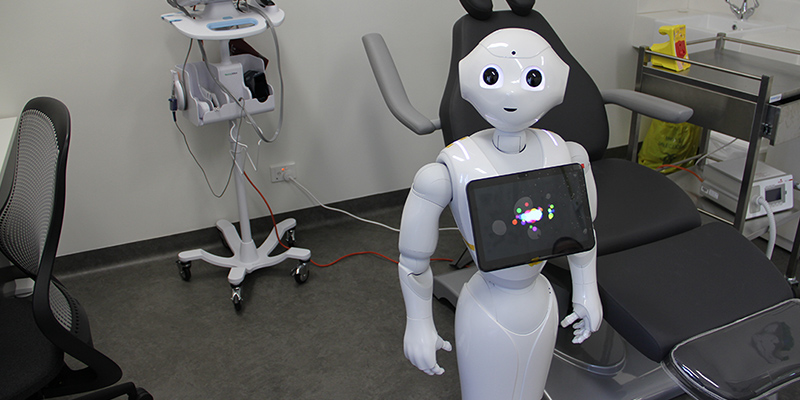Hi. How can I help you? Health clinic embraces the robot age
By Dan Lander
 COMMUNITY
COMMUNITYIt’s only a matter of time before robots become as ubiquitous in GP clinics as the stethoscope and blood pressure monitor, executive director of UniSA’s Hawke EU Jean Monnet Centre of Excellence Professor Anthony Elliott wrote in a recent op-ed for The Australian.
Or, in the case of UniSA’s City West Health and Medical Clinic, it’s a matter of no time at all.
The Health and Medical Clinic recently acquired a humanoid robot named Pepper, a rather charming automaton who will be involved in day-to-day clinic activity and provide students unrivalled access to advanced technology.
Dean of Clinical Education and Equity, Professor Esther May, views Pepper as an integral part of a wider strategy to introduce students to the potential of robotics in health practice, developing their understanding of the technology as means of early exposure to new and future ways of working.
Health and Clinical Education Manager, Dr Kuan Liung Tan, says the new robot, which is developed by SoftBank Robotics Corp, is the first of its kind in South Australia, and will be among the first in the world to be fully integrated into a professional healthcare environment.
“Pepper is essentially a blank canvas, and the challenge comes in programming and adapting it to your own ends,” Dr Tan says. “What we hope to use it for here at the clinic will be world-leading, and we will be pushing the boundaries of human-robot interaction.”
The clinic has two parallel development timelines for Pepper, the first of which should see the robot serving as an onsite ambassador within the next six months, greeting patients, providing information about services and gathering feedback.
“Pepper is used in a similar way in a few banks, restaurants and clinics overseas,” Dr Tan says. “Voice recognition and facial recognition allow the robot to identify patients and talk to them, to assist people in their basic dealings with the clinic.”
Phase 2 will see robot provide exercise education and cognitive training
The next phase of integration is more ambitious, with Dr Tan to oversee the development of bespoke programs allowing Pepper to function as both a therapist and a ‘patient’, utilising some of the unit’s more advanced functionality, such as the ability to recognise emotion in a face or voice.
“Currently, a few limited programs allow Pepper to do things like lead a meditation session, but we are looking beyond that to functions like exercise and stretching education, cognitive training and even therapeutic interaction with autism patients,” Dr Tan says.
“In another capacity, some of our students, especially international students, lack confidence in communicating and interacting with real patients when they start to practise in the real world.
“Pepper can ‘simulate’ a real-life patient, so that students can interact with it and improve clinical communication skills.”
Dr Tan is currently looking for interested students and academics to collaborate on the conception and development of programs for Pepper and views this as an exciting opportunity for interdisciplinary exchange across a range of fields at UniSA.
“The aim is to have medical experts working with experts from other areas such as software development, interface design and digital communications, to really test what this technology can do,” Dr Tan says. “Pepper represents an amazing opportunity not just for the clinic, but for anyone who wants hands-on access to technology that is going to play a very important role in the future.”
Anyone with genuine interest in working on the development of Pepper can contact Dr Tan on 8302 2033 or kuan.tan@unisa.edu.au.
Other Stories
- Painless needles on the way for vaccinations
- Hi. How can I help you? Health clinic embraces the robot age
- Virtual health coach ‘Paola’ will help you get fit and eat well
- Carbon-free renewable energy solution to ‘heat up’ industry
- From the Vice Chancellor
- Achievements and Announcements
- The technology to take a jury into a 3D crime scene
- Oscars 2019 plays it safe with Green Book, lacks enlightened thinking
- Organ-on-a-chip technology to reduce side effects of radiotherapy
- Find out about UniSA’s dedicated student support services (Video)
- International defence research lab with France planned for Adelaide
- New innovation hub in Whyalla to nurture regional startups
- The latest books from UniSA researchers
- In Pictures




